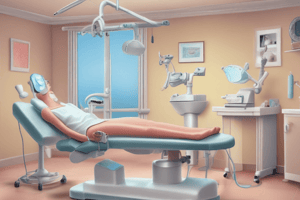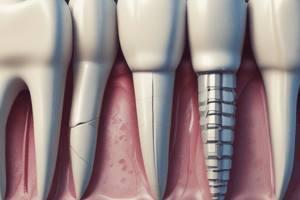Podcast
Questions and Answers
What is the first step in the development of a treatment plan?
What is the first step in the development of a treatment plan?
- Full clinical examination
- The process of information gathering (correct)
- Completing all the required investigations
- Establishing diagnosis
Which phase of treatment involves restoration of function and esthetics?
Which phase of treatment involves restoration of function and esthetics?
- Phase IV: Re-evaluation and recall
- Phase III: Restoration of function and esthetic (correct)
- Phase I: Priority Treatment
- Phase II: Disease Control
What is a critical factor that affects the treatment plan?
What is a critical factor that affects the treatment plan?
- Type of dental practice
- Age of the patient (correct)
- Patient's location
- Availability of dental materials
What does the statement 'the dentist can only anticipate treatment results' imply?
What does the statement 'the dentist can only anticipate treatment results' imply?
What is the purpose of providing patients with different treatment options?
What is the purpose of providing patients with different treatment options?
Which of the following is NOT a phase in the outlined treatment plan?
Which of the following is NOT a phase in the outlined treatment plan?
Why might time be necessary before determining the success of treatment?
Why might time be necessary before determining the success of treatment?
What should be done first when developing a diagnosis for treatment?
What should be done first when developing a diagnosis for treatment?
Flashcards
Treatment Plan
Treatment Plan
A comprehensive plan outlining the steps needed to address a patient's dental needs. It involves gathering patient information, conducting a thorough examination, completing necessary investigations, and establishing a diagnosis.
Phase I: Priority Treatment
Phase I: Priority Treatment
The initial phase of treatment, focusing on addressing the patient's most pressing concerns, such as pain relief and controlling infections.
Phase II: Disease Control
Phase II: Disease Control
The phase where efforts are concentrated on managing and controlling existing dental diseases, including caries and periodontal disease.
Phase III: Restoration of Function and Esthetic
Phase III: Restoration of Function and Esthetic
Signup and view all the flashcards
Phase IV: Re-evaluation and Recall
Phase IV: Re-evaluation and Recall
Signup and view all the flashcards
Optimum Treatment Plan
Optimum Treatment Plan
Signup and view all the flashcards
Convenient Treatment Plan
Convenient Treatment Plan
Signup and view all the flashcards
Alternative Treatment Plan
Alternative Treatment Plan
Signup and view all the flashcards
Study Notes
Treatment Plan Overview
- A dental treatment plan is a strategy for addressing patient complaints, based on diagnostic information and a problem list.
- Effective treatment planning is a challenging aspect of dentistry.
- A treatment plan is like a roadmap, providing guidance and direction.
Aims and Objectives of a Treatment Plan
- Manage emergencies (e.g., pain relief).
- Prioritize patient needs.
- Restore function and aesthetics.
- Achieve the highest standard of care.
- Prevent further oral health deterioration.
Developing a Treatment Plan
- Treatment plans are developed through information gathering.
- Full clinical examination is crucial.
- Necessary investigations must be completed.
- Diagnoses must be established.
Types of Treatment Plans
- Emergency dental treatment: Immediate care for urgent issues.
- Limited treatment plan: A reduced scope of care for less severe problems.
- Provisional treatment plan: A temporary solution, often used before a final plan.
- Comprehensive treatment plan: A complete, thorough treatment approach.
Phases of a Comprehensive Treatment Plan
- Pretreatment phase: Includes specialized radiographs (CT, MRI), study models, and consultations (medical or dental).
Format of a Treatment Plan (General Format)
- Manage the patient's chief complaint.
- Eliminate pain and significant diseases.
- Address elective procedures.
- Divide the treatment into smaller phases.
Phase I (Priority Care)
- Importance: Eliminate pain and manage acute infections
- Examples
- Teeth with pulpal involvement
- Teeth with caries near the pulp
- Painful periodontal conditions (ANUG, pericoronitis)
- Suspicious bony and mucosal lesions
- Rampant caries approaching the pulp
Phase II (Disease Control)
- Importance: Control all disease processes, without complete eradication.
- Examples:
- Management of chief complaints (if not completed in Phase I)
- Extensive oral surgery (e.g., removal of remaining roots)
- Endodontic treatment
- Oral hygiene instructions
- Periodontic services
- Orthodontic treatment
- Occlusal analysis (e.g., fremitus)
Phase III (Restoration of Function & Aesthetics)
- Importance: Restoring the mouth to full function and aesthetics.
- Examples:
- Placement of amalgam or colored restorations.
- Completing procedures prior to prosthetics.
- Placing crowns and fixed bridges
- Delivering complete or removable dentures
Phase IV (Re-evaluation & Recall)
- Importance: Ensure procedures are complete, and address any new issues or traumas.
- Follow up appointments are crucial, particularly in endodontics or periodontics.
- Routine re-evaluations (check-ups) are equally important.
Factors Affecting Treatment Plans
- Patient Systemic Health: Examples include diabetes, heart conditions, pregnancy, etc.
- Patient Age: Physiologic age vs. Chronic age, pulp size, and developmental considerations.
- Patient Expectations: Past experiences, concerns, and opinions about treatment.
- Psychological Factors: Patient's mood, chief complaint, and personality type.
- Existing Dental Conditions: Caries, periodontal disease, missing teeth.
- Operator Experience and Philosophy: Dentist's experience, specialization, and decision-making process.
- Financial Considerations: Cost of treatment and associated factors.
Prognosis of a Treatment Plan
- Teeth with stable prognosis: No significant issues expected
- Teeth with guarded prognosis: Potential issues are likely, but temporary problems.
- Teeth with diminished prognosis: Significant problems, likely require frequent intervention
- Teeth with hopeless prognosis: Untreatable, recommend removal.
Is the plan 100% accurate?
- It is not possible to have a 100% treatment outcome due to the patient being a living biological entity.
- Treatment can be anticipated, but not guaranteed
Additional notes
- Treatment flexibility is crucial.
- Adjusting treatment strategies may be required over time.
- Patient-specific needs should be addressed
- Dental treatment plans should incorporate convenience and optimization for the patient's benefit.
- Proper communication and providing different options are key to building trust.
Studying That Suits You
Use AI to generate personalized quizzes and flashcards to suit your learning preferences.




